Papers by arnold herskovic
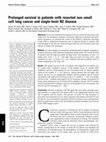
The Journal of Thoracic and Cardiovascular Surgery, Jul 1, 2004
Objectives: To test the hypothesis that patients with non-small cell lung cancer and single-level... more Objectives: To test the hypothesis that patients with non-small cell lung cancer and single-level N2 metastases constitute a favorable subgroup of patients with mediastinal metastases, we analyzed the results of the Eastern Cooperative Oncology Group 3590 (a randomized prospective trial of adjuvant therapy in patients with resected stages II and IIIa non-small cell lung cancer) by site of primary tumor and pattern of lymph node metastases. Methods: Accurate staging was ensured by mandating either systematic sampling or complete dissection of the ipsilateral mediastinal lymph nodes. The overall survival of patients with left lung non-small cell lung cancer and metastases in only 1 of lymph node levels 5, 6, or 7 and right lung non-small cell lung cancer with metastases in only 1 of levels 4 or 7 was compared with that of patients with N1 disease originating in the same lobe. The median survival of the 172 patients with single-level N2 disease was 35 months (95% confidence interval: 27-40 months) versus 65 months (95% confidence interval: 45-84 months) for the 150 patients with N1 disease (median follow-up 84 months, P ϭ .01). However, among patients with left upper lobe tumors, survival was not significantly different between patients with N1 disease and patients with single-level N2 disease (49 vs 51 months, P ϭ .63). The median survival of the 71 patients with single-level N2 metastases without concomitant N1 disease (skip metastases) was 59 months (95% confidence interval: 36-107 months) versus 26 months (95% confidence interval: 16-36 months) for the 145 patients with both N1 and N2 metastases (P ϭ .001). Conclusions: Survival of patients with left upper lobe non-small cell lung cancer and metastases to single-level N2 lymph nodes is not significantly different from that of patients with N1 disease. The presence of isolate N2 skip metastases is associated with improved survival when compared with patients with both N1 and N2 disease. Survival should be reported by the lobe of primary tumor and metastatic pattern to guide future clinical trial development, treatment strategies, and revisions of the TNM staging system. C ontroversy continues to surround the role of surgery for patients with non-small cell lung cancer (NSCLC) and metastases to the N2 lymph nodes. Although the clinical course of patients with resected N2 disease has been extensively documented, definitive conclusions regarding the results of treatment are lacking. The continued confusion results from the dissimilar clinical and pathologic categories that comprise N2 disease. Numerous factors seem to impact the survival of patients with resected N2 disease. Among them are the manner in which the N2 disease was identified, the performance of mediastinoscopy, the thoroughness of intraoperative lymph node assessment, the location of the lymph node, and the number of nodal levels From the Departments of Cardiothoracic
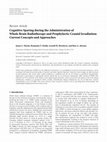
Journal of Oncology, 2010
Whole brain radiotherapy (WBRT) for the palliation of metastases, or as prophylaxis to prevent in... more Whole brain radiotherapy (WBRT) for the palliation of metastases, or as prophylaxis to prevent intracranial metastases, can be associated with subacute and late decline in memory and other cognitive functions. Moreover, these changes are often increased in both frequency and severity when cranial irradiation is combined with the use of systemic or intrathecal chemotherapy. Approaches to preventing or reducing this toxicity include the use of stereotactic radiosurgery (SRS) instead of WBRT; dose reduction for PCI; exclusion of the limbic circuit, hippocampal formation, and/or neural stem cell regions of the brain during radiotherapy; avoidance of intrathecal and/or systemic chemotherapy during radiotherapy; the use of high-dose, systemic chemotherapy in lieu of WBRT. This review discusses these concepts in detail as well as providing both neuroanatomic and radiobiologic background relevant to these issues.

The New England Journal of Medicine, Oct 26, 2000
We conducted a randomized trial to determine whether combination chemotherapy plus thoracic radio... more We conducted a randomized trial to determine whether combination chemotherapy plus thoracic radiotherapy is superior to thoracic radiotherapy alone in prolonging survival and preventing local recurrence in patients with completely resected stage II or IIIa non-small-cell lung cancer. After surgical staging and resection of the tumor (usually by lobectomy or pneumonectomy), the patients were randomly assigned to receive either four 28-day cycles of cisplatin (60 mg per square meter of body-surface area intravenously on day 1) and etoposide (120 mg per square meter intravenously on days 1, 2, and 3) administered concurrently with radiotherapy (a total of 50.4 Gy, given in 28 daily fractions) or radiotherapy alone (a total of 50.4 Gy, given in 28 daily fractions). Of the 488 patients who were enrolled in the study, 242 were assigned to receive radiotherapy alone and 246 were assigned to receive chemotherapy and radiotherapy. The median duration of followup was 44 months. Treatment-associated mortality was 1.2 percent in the group given radiotherapy alone and 1.6 percent in the group given chemotherapy and radiotherapy. The median survival was 39 months in the group given radiotherapy and 38 months in the group given chemotherapy and radiotherapy (P= 0.56 by the log-rank test). The relative likelihood of survival among patients assigned to receive chemotherapy and radiotherapy, as compared with those assigned to receive radiotherapy alone, was 0.93 (95 percent confidence interval, 0.74 to 1.18). Intrathoracic disease recurred within the radiation field in 30 of 234 patients (13 percent) in the group given radiotherapy and in 28 of 236 patients (12 percent) in the group given chemotherapy and radiotherapy (P=0.84); data on recurrence were not available for 18 patients.

Journal of Clinical Oncology, 1997
The present intergroup phase III randomized study compared combined chemotherapy (CT) plus radiot... more The present intergroup phase III randomized study compared combined chemotherapy (CT) plus radiotherapy (RT) treatment versus RT only in patients with locally advanced esophageal cancer. Two courses of chemotherapy during 50 Gy RT followed by additional two courses of the same CT, versus 64 Gy RT alone were investigated. CT consisted of cisplatin 75 mg/m2 on day 1 [corrected] and fluorouracil (5FU) 1,000 mg/m2/d on days 1 to 4 every 4 weeks with RT and every 3 weeks post-RT. The main objective of the study was to compare overall survival between the two randomized treatment groups. Patients were stratified by tumor size, histology, and degree of weight loss. Sixty-two assessable patients were randomized to receive RT alone, and 61 to the combined arm. Patients characteristics were as follows: squamous cell cancer, 90% versus 85%; weight loss greater than 10 lb, 61% versus 69%; and tumor size, > or = 5 cm, 82% versus 80% on the RT and CT-RT arms, respectively. Systemic side effects, which consisted of nausea, vomiting, and renal and myelosuppression, occurred more frequently on the combined arm, while local side effects were similar in both groups. With a minimum follow-up time of 5 years for all patients, the median survival duration was 14.1 months and the 5-year survival rate was 27% in the combined treatment group, while the median survival duration was 9.3 months with no patients alive at 5 years in the RT-alone group (P < .0001). Additional patients (69) were treated with the same combined therapy and were analyzed. The results of the last group confirmed all of the results obtained with combined CT-RT in the randomized trial, with a median survival duration of 17.2 months and 3-year survival rate of 30%. We conclude that cisplatin and 5FU infusion given during and post-RT of 50 Gy is statistically superior to standard 64-Gy RT alone in patients with locally advanced esophageal cancer.

JAMA, May 5, 1999
HE RISK OF ESOPHAGEAL CANcer is growing; over the past 20 years the incidence rate has increased ... more HE RISK OF ESOPHAGEAL CANcer is growing; over the past 20 years the incidence rate has increased 14.8%. 1 Moreover, carcinomas of the esophagus have been among the most resistant to treatment. Mean survival following traditional therapy has approximated only 9 months. Earlam and Cuhna-Melo's 2 1980 review of 122 articles describing the surgical care of 83 783 cases of squamous cell carcinoma of the esophagus revealed a paltry 5-year survival rate of 4%. Their subsequent review of the role of radiation therapy (RT) found an almost equally dismal rate of 6%. 3 While improvements in technique have occurred and more modern surgical series tend to report survival rates in the 20% range, at least some investigators believe the major explanation for this has been earlier detection of tumors. The first evidence that the integration of chemotherapy with RT could improve outcome surfaced in the early 1980s. Sev-
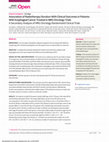
JAMA network open, Apr 21, 2023
IMPORTANCE For many types of epithelial malignant neoplasms that are treated with definitive radi... more IMPORTANCE For many types of epithelial malignant neoplasms that are treated with definitive radiotherapy (RT), treatment prolongation and interruptions have an adverse effect on outcomes. OBJECTIVE To analyze the association between RT duration and outcomes in patients with esophageal cancer who were treated with definitive chemoradiotherapy (CRT). This study was an unplanned, post hoc secondary analysis of 3 prospective, multi-institutional phase 3 randomized clinical trials (Radiation Therapy Oncology Group [RTOG] 8501, RTOG 9405, and RTOG 0436) of the National Cancer Institute-sponsored NRG Oncology (formerly the National Surgical Adjuvant Breast and Bowel Project, RTOG, and Gynecologic Oncology Group). Enrolled patients with nonmetastatic esophageal cancer underwent definitive CRT in the trials between 1986 and 2013, with follow-up occurring through 2014. Data analyses were conducted between March 2022 to February 2023. EXPOSURES Treatment groups in the trials used standard-dose RT (50 Gy) and concurrent chemotherapy. The outcomes were local-regional failure (LRF), distant failure, disease-free survival (DFS), and overall survival (OS). Multivariable models were used to examine the associations between these outcomes and both RT duration and interruptions. Radiotherapy duration was analyzed as a dichotomized variable using an X-Tile software to choose a cut point and its median value as a cut point, as well as a continuous variable. The analysis included 509 patients (median [IQR] age, 64 [57-70] years; 418 males [82%]; and 376 White individuals [74%] ). The median (IQR) follow-up was 4.01 (2.93-4.92) years for surviving patients. The median cut point of RT duration was 39 days or less in 271 patients (53%) vs more than 39 days in 238 patients (47%), and the X-Tile software cut point was 45 days or less in 446 patients (88%) vs more than 45 days in 63 patients (12%). Radiotherapy interruptions occurred in 207 patients (41%). Female (vs male) sex and other (vs White) race and ethnicity were associated with longer RT duration and RT interruptions. In the multivariable models, RT duration longer than 45 days was associated with inferior DFS (hazard ratio [HR], 1.34; 95% CI, 1.01-1.77; P = .04). The HR for OS was 1.33, but the results were not statistically significant (95% CI, 0.99-1.77; P = .05). Radiotherapy duration longer than 39 days (vs Յ39 days) was associated with a higher risk of LRF (HR, 1.32; 95% CI, 1.06-1.65; P = .01). As a continuous variable, RT duration (per 1 week increase) was (continued) Key Points Question Is there an association between radiotherapy (RT) duration and clinical outcomes in patients with esophageal cancer receiving definitive chemoradiotherapy? Findings In this secondary analysis of 3 NRG Oncology randomized clinical trials, prolonged RT duration was associated with inferior disease-free survival. Female patients and those with other (vs White) race and ethnicity were more likely to have prolonged RT duration and to experience RT interruptions. Meaning Findings of this study suggest that RT interruptions should be minimized to optimize outcomes.
Superiority of combined chemoradiotherapy to radiotherapy alone in patients with esophageal cance... more Superiority of combined chemoradiotherapy to radiotherapy alone in patients with esophageal cancers. An intergroup study.
International Journal of Radiation Oncology Biology Physics, 1991
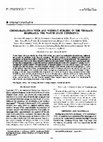
International Journal of Radiation Oncology Biology Physics, Sep 1, 1988
Wayne State University was the site of one of the initial experiences with combination chemothera... more Wayne State University was the site of one of the initial experiences with combination chemotherapy, radiation, and surgery for carcinoma of the thoracic esophagus. This review analyzes all the patients seen with thoracic esophageal carcinoma from 1980 to 1984 inclusive, plus an additional 22 patient pilot study. The great majority of patients seen were treated with combination radiation and chemotherapy, which may have a greater applicability than does esophagectomy. Eighty-nine patients completed planned preoperative treatment consisting of (5-FU cisplatin and radiation therapy). Of these patients, 39 patients refused or were not offered surgery, and 4 patients are still alive and well several years from treatment initiation. Fifty patients underwent esophagectomy. Twelve of this patients were free of tumor at esophagectomy, and 4 of these are still alive and well several years from treatment. One patient with residual tumor in the esophagectomy specimen alone is still alive. Because of disap pointing results and surgical mortality risk, 22 patients were entered on the pilot study, increasing the tumor dose of 5000 cGy, and increasing chemotherapy to 4 courses. Six patients are still alive in this small series. Since the results of radiation and chemotherapy combination approximates that of best prior trials of radiation therapy alone, a randomized study has been initiated comparing these treatment plans to determine if the combination of radiation and chemotherapy is superior to radiation alone.
Computerized Tomography, 1979
A simple method CT scanners which were readily available is described in which alignment of the i... more A simple method CT scanners which were readily available is described in which alignment of the isodose curves can be made directly on the printout of the CT scan. This has obvious practical and theoretical advantages. In particular, the dose to vital structures, such as spinal cord and other critical viscera. can be well described. Interstitial implant Isodose curves CT scanner, anatomic location and dosage
Radiology, Aug 1, 1979
A "German helmet" field defined by depleted uranium or Asarcola... more A "German helmet" field defined by depleted uranium or Asarcola blocks was used to reduce the dose to the lens. With the uranium blocks, the lenticular dose was reduced to about 60% of the central axis dose (CAD). The Asarcola blocks reduced the lenticular dose to about 43% of the CAD. Even further reduction (15% CAD) was achieved by tilting the gantry 5 degrees or 10 degrees.

Lung Cancer, Jun 1, 1997
Survival outcome of 1592 analyzable patients on four Radiation Therapy Oncology Group (RTOG) stud... more Survival outcome of 1592 analyzable patients on four Radiation Therapy Oncology Group (RTOG) studies in inoperable non-small cell lung cancer were studied utilizing a recursive partitioning analysis (RPA). This approach creates a regression tree according to prognostic variables which partitions into homogenous subsets according to survival. Four protocols, RTOG 83-11, 83-21, 84-03 and 84-07 were analyzed. 83-11 and 84-07 were studies utilizing irradiation with alterfractionation; 83-21 and 84-03 were studies evaluating thymocin with irradiation and prophylactic cranial irradiation with thoracic irradiation respectively. Nine pretreatment variables and one treatment variable were analyzed. Adjustment for radiotherapy effect was made in the accelerated treatment protocol (84-07). Overall, median survival for the entire group was 9.0 months with 17% alive at 2 years. Univariate analysis suggests that KPS, I 70 vs. 80-100, pleural effusion, weight loss, I 5% vs. 5%, age, 60 + vs. < 60, T stage (Tl and T2 vs. T3 and T4) and N stage (N-vs. N + > were important prognastic factors. Radiation dose, sex, race and histology were not univariate prognastic factors. RPA
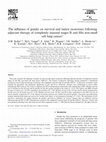
Lung Cancer, Sep 1, 2002
This study evaluates the influence of gender on survival and tumor recurrence following adjuvant ... more This study evaluates the influence of gender on survival and tumor recurrence following adjuvant therapy of completely resected stages II and IIIa non-small cell lung cancer (NSCLC). The Eastern Cooperative Oncology Group conducted a randomized prospective trial of adjuvant therapy in patients with completely resected stages II and IIIa NSCLC. A laboratory correlative study assessed the prevalence and prognostic significance of p53 and K-ras mutations. Patients were randomized to receive either radiotherapy (RT) alone or four cycles of cisplatin and VP-16 administered concurrently with radiotherapy (CRT). Median survival was 35 months for the 285 men and 41 months for the 203 women enrolled in the study (P0/0.12). The relative risk (RR) of death for men vs women was 1.19 (95% confidence interval [CI], 0.95 Á/1.49). Median survival of the 147 men and 95 women randomized to the RT arm was 39 months each (P0/0.35). Median survival of the 138 men and 108 women randomized to the CRT arm was 30 and 42 months, respectively (P0/0.18). Disease recurrence patterns were similar between the genders. Univariate and multivariate analyses demonstrated improved survival for women with tumors of non-squamous histology (P B/0.01). The distribution of p53 and K-ras mutations was similar between the genders and had no influence on survival. Gender does not influence survival following adjuvant RT or CRT administered to patients with completely resected stages II and IIIa NSCLC. However, women with non-squamous histology have increased survival when compared to men.
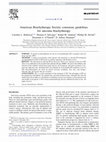
International Journal of Radiation Oncology Biology Physics, Apr 1, 1997
PURPOSE: To present recommendations for the use of brachytherapy (BT) in patients with soft tissu... more PURPOSE: To present recommendations for the use of brachytherapy (BT) in patients with soft tissue sarcoma (STS). METHODS: A group of practitioners with expertise and experience in sarcoma BT formulated recommendations for BT in STS based on clinical experience and literature review. RESULTS: The indications for adjuvant BT are discussed. There is no consensus on the use of BT alone or in combination with external beam radiation therapy (EBRT), but factors that influence the selection of this modality include tumor grade and size, prior surgeries, and tumor recurrence. Lowdose-rate, high-dose-rate, and pulsed-dose-rate radiation are all acceptable BT modalities to use for STS. Recommendations are made for patient selection, techniques, dose rates, and dosages. Outcome data and toxicity data are reviewed. CONCLUSIONS: BT is a useful component of the treatment of STS. The advantages of BT are the targeted dose distribution, low integral dose, and short treatment times. Ultimately the clinician should select the modality or combination of modalities that are most familiar to the treatment team and suitable to the patient.

Cancer Investigation, 2000
We developed an accelerated hyperfractionation schedule with acceptable effect and toxicity in no... more We developed an accelerated hyperfractionation schedule with acceptable effect and toxicity in non-small cell bronchogenic carcinomas. An evolutionary institutional pilot was initiated in March 1995 as a modification of Radiation Therapy Oncology Group (RTOG) 9205, thrice-daily fractionation schedule. Twenty-nine patients with bronchogenic and 7 with head and neck cancers had treatment initiated and completed. A dose of 1.2 Gy was delivered to a mediastinal plus tumor field concomitantly with synchronous boost of 0.6 Gy to a limited volume of gross tumor (twice daily for 21 treatments days in 4 weeks) with a total dose being 75.60 Gy to the primary gross tumor and 50.4 Gy to the elective volume. The bronchogenic cancers were stages IB (medically unresectable, n = 3), IIB (n = 4), IIIA (n = 4), or IIIB (n = 18). Eleven patients had squamous cell cancers, 13 adenocarcinomas, 1 large cell, and 2 carcinomas not specified. With 12 months median follow-up, tolerance has been excellent without any patient complaining of at least Oncology Nursing Society (ONS) grade 3 esophagitis; treatment interruptions occurred in only one patient after 8 days. Weight loss occurred in 12 patients, averaging 4.8% for these patients and 2% overall. Seven patients had a complete response and 20 a partial response. Median survival was 12 months, 1-year survival 58%, 2-year 21%, and 3-year 18%. Seven patients with bronchogenic cancer are still alive. Seven head and neck cancer patients were treated, in which five had base of tongue tumors stage T2 to 4, N0 to N1. Pharyngitis and mucositis were problematic in at least four patients. The outcomes are comparable with other RTOG experience. Hyperfractionated synchronous concomitant boost of total tumor dose to 75.6 Gy in 4 weeks for bronchogenic patients was well tolerated and acceptable to physicians and patients.

Cancer, Nov 1, 1996
Continuous infusion 5-fluorouracil (CI5-FU) has been utilized concurrently with radiotherapy to i... more Continuous infusion 5-fluorouracil (CI5-FU) has been utilized concurrently with radiotherapy to improve tumor control. In this pilot trial, cisplatin, CI5FU, and radiotherapy were utilized for the treatment of locoregional esophageal carcinoma. It was postulated that the combination would be well tolerated and associated with high response rate and survival duration. Thirty-two eligible patients with locoregional squamous cell carcinoma and adenocarcinoma of the esophagus received a regimen consisting of the following: radiotherapy, 50 Gray (Gy) (30 Gy anteroposterior/posteroanterior regional with 20 Gy AP/LPO/RPO boost) over 5 weeks, with CI5-FU 250 mg/m2/d for the duration of radiotherapy and cisplatin 25 mg/m2/day on Days 1-3 during Weeks 1 and 4 of the radiotherapy cycle. Upon completion of radiotherapy, two additional course, of cisplatin 75 mg/m2 on Days 1 and 29 and CI5-FU 300 mg/m2/day on Days 1-21 and 29-50 were delivered. Following imaging and endoscopic reassessment, patients with no evidence of disease received more chemotherapy. Surgery was suggested only for patients with residual local disease. Complete response was demonstrated in 44% of patients, clinically in 12 patients, and during surgery in 2 others. The median survival was 20 months, and the 1-year survival rate was 59%. Toxicity was severe, comprised of esophagitis, infection, and gastrointestinal complications. Dose delays and reductions occurred in the majority of patients. Four early deaths were noted. The regimen that was the focus of this trial has been active in the treatment of esophageal carcinoma. However, compared with existing regimens, its complexity and toxicity preclude its future use without modifications.

Journal of Clinical Oncology, Mar 1, 1984
Thirty-four patients with renal cell carcinoma and brain metastases were reviewed to define impor... more Thirty-four patients with renal cell carcinoma and brain metastases were reviewed to define important prognostic factors and treatment results. The following covariates were analyzed to determine their influence on survival: disease-free interval, serum calcium, number of central nervous system (CNS) metastases, weight loss, performance score, age, radiation therapy, surgery, and surgery plus radiation. The mean survival for all patients was 7.0 months (range, seven days to 32 months). The patients with a good performance score of 0-2 survived significantly longer (mean survival, 10.2 months) than those with a poor performance score of 3-4 (mean survival, 2.8 months; p = 0.0019). Surgery was associated with significantly improved survival (mean survival, 13.8 months versus mean survival, 4.2 months; p = 0.014). However, all the surgical patients were from the good performance score group, suggesting patient selection. Radiation was associated with an improved mean survival of 8.6 months versus 3.2 months. Performance score is a significant prognostic factor. Furthermore, the data support treatment with radiation therapy for patients with multiple CNS metastases and surgery followed by postoperative radiation therapy for patients with single CNS metastases.

Journal of Clinical Oncology, Feb 1, 1997
The present intergroup phase III randomized study compared combined chemotherapy (CT) plus radiot... more The present intergroup phase III randomized study compared combined chemotherapy (CT) plus radiotherapy (RT) treatment versus RT only in patients with locally advanced esophageal cancer. Two courses of chemotherapy during 50 Gy RT followed by additional two courses of the same CT, versus 64 Gy RT alone were investigated. CT consisted of cisplatin 75 mg/m2 on day 1 [corrected] and fluorouracil (5FU) 1,000 mg/m2/d on days 1 to 4 every 4 weeks with RT and every 3 weeks post-RT. The main objective of the study was to compare overall survival between the two randomized treatment groups. Patients were stratified by tumor size, histology, and degree of weight loss. Sixty-two assessable patients were randomized to receive RT alone, and 61 to the combined arm. Patients characteristics were as follows: squamous cell cancer, 90% versus 85%; weight loss greater than 10 lb, 61% versus 69%; and tumor size, &gt; or = 5 cm, 82% versus 80% on the RT and CT-RT arms, respectively. Systemic side effects, which consisted of nausea, vomiting, and renal and myelosuppression, occurred more frequently on the combined arm, while local side effects were similar in both groups. With a minimum follow-up time of 5 years for all patients, the median survival duration was 14.1 months and the 5-year survival rate was 27% in the combined treatment group, while the median survival duration was 9.3 months with no patients alive at 5 years in the RT-alone group (P &lt; .0001). Additional patients (69) were treated with the same combined therapy and were analyzed. The results of the last group confirmed all of the results obtained with combined CT-RT in the randomized trial, with a median survival duration of 17.2 months and 3-year survival rate of 30%. We conclude that cisplatin and 5FU infusion given during and post-RT of 50 Gy is statistically superior to standard 64-Gy RT alone in patients with locally advanced esophageal cancer.
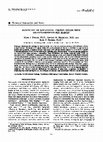
International Journal of Radiation Oncology Biology Physics, Mar 1, 1984
Evdving mdiotbempeutic tectmiqw is aimed at routioe use of an eye protection accessory witb onifo... more Evdving mdiotbempeutic tectmiqw is aimed at routioe use of an eye protection accessory witb oniformity of dose to facial tumors. Rotational 4 MV photon fields witk grrvity+xiented eye blocks are described in applications to patients and a phtom. A mad&-oriented compeusator witk a slit and beveled edges at eye levels has been applied to increase urdformity of dose over the e&ire target, iochding partly blocked regions. Treatment phming parameters are derived from simple geometric relatiooship& Dose distributions sod average tissue-air ratios (TAR) are cdculated witk a conventional radiotkerapeotic treatment phming system, and measured during initial @e&meats via tbermohninescent dosemeters (TLD) in facial cavities. Mackine monitor units of initial treatments (MUI) are calculated from prescribed dose D, TAR, m isodose lioes, dose rates in air, and compenortor tmmmimioa; for subeeqoent treatments, MU1 are mod&d using averages of u&locked target doses fi m during in&id treatme& MU2 = @/b)MUl. Doses measured on patients' eyelids have beea 10 to 15% of prescribed dose. Three dimenGonal dose distributior~ were detexmined using TLD in an antkropomor@ic pbantom. With beam compensation, eye doses were 15% of uoblocked target doses, doses to partly blocked target were 86 to 129% of unblocked target doses, and doses to unblocked target showed 5% mean standard deviations. In uioo and in phantom data were codstent witb computer-calculated distribatiom~ For uniformity of target dose, eywpariug, and simplicity of irradiating tmnors surromhg the eyes, the technique investigated compares favorably with conventional techniqoes.
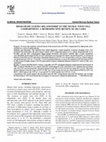
International Journal of Radiation Oncology Biology Physics, Feb 1, 2012
Purpose: To assess the incidence of involvement of the neural stem cell (NSC) compartment by high... more Purpose: To assess the incidence of involvement of the neural stem cell (NSC) compartment by high-grade astrocytomas in a series of adult patients. Methods and Materials: One hundred four initial diagnostic cranial magnetic resonance imaging series were reviewed. For each series, the gross tumor volume (GTV; enhancing tumor on T 1 ), edema (hyperintensity on T 2 FLAIR), and the NSC compartment (hippocampal formation and lateral ventricle plus a 5-mm expansion) were identified. Involvement of NSC by GTV and edema was assessed. For tumors not involving NSC, we measured distances from NSC to GTV and edema. Maximum diameters of GTV were measured for each case. Subset analysis was performed for GTV of #2 cm and #3 cm in maximum diameter to assess the incidence of involvement of NSC by this group of smaller tumors. For 10 representative tumors, minimum distances from GTV center to NSC were calculated. Results: A total of 103/104 (99.0%) tumors, regardless of GTV maximum diameter, demonstrated involvement of NSC. A total of 101/104 (97.1%) tumors had NSC involvement by GTV, and 2/104 (1.9%) patients showed edema only. For GTV not involving NSC, the mean distance from NSC to GTV was 0.8 cm (range, 0.5-1.4 cm). The mean shortest distance from the center of GTV to NSC was 1.5 cm (range, 0.9-2.6 cm). Involvement of NSC by GTV was 90.9% (10/11 tumors) for GTV of #2 cm and 95.7% (22/23 tumors) for GTV of #3 cm. Conclusions: Our results support the hypothesis that the NSC compartment represents the putative site of origin for these tumors. NSC involvement does not appear to represent a volumetric phenomenon. Ó 2012 Elsevier Inc. Neural stem cell, Glioma.









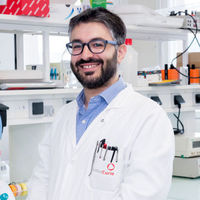

Uploads
Papers by arnold herskovic